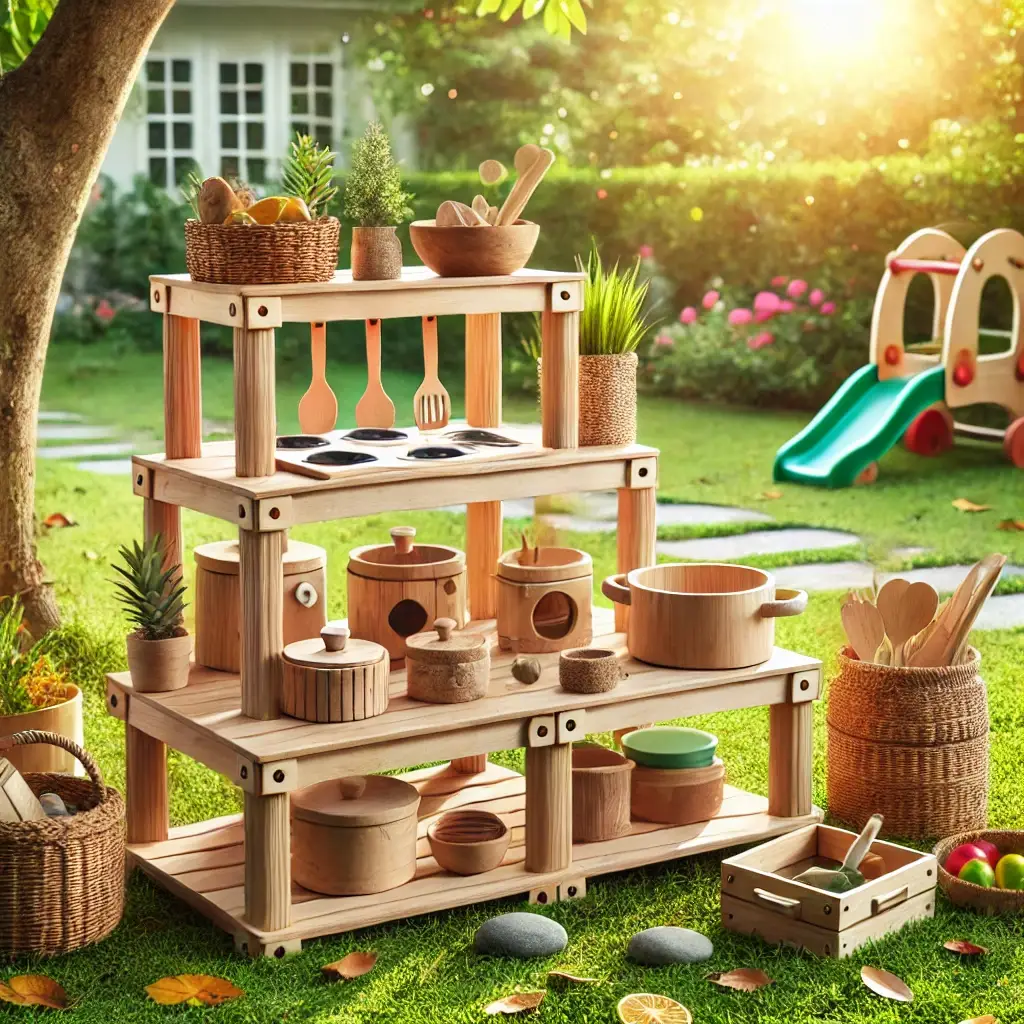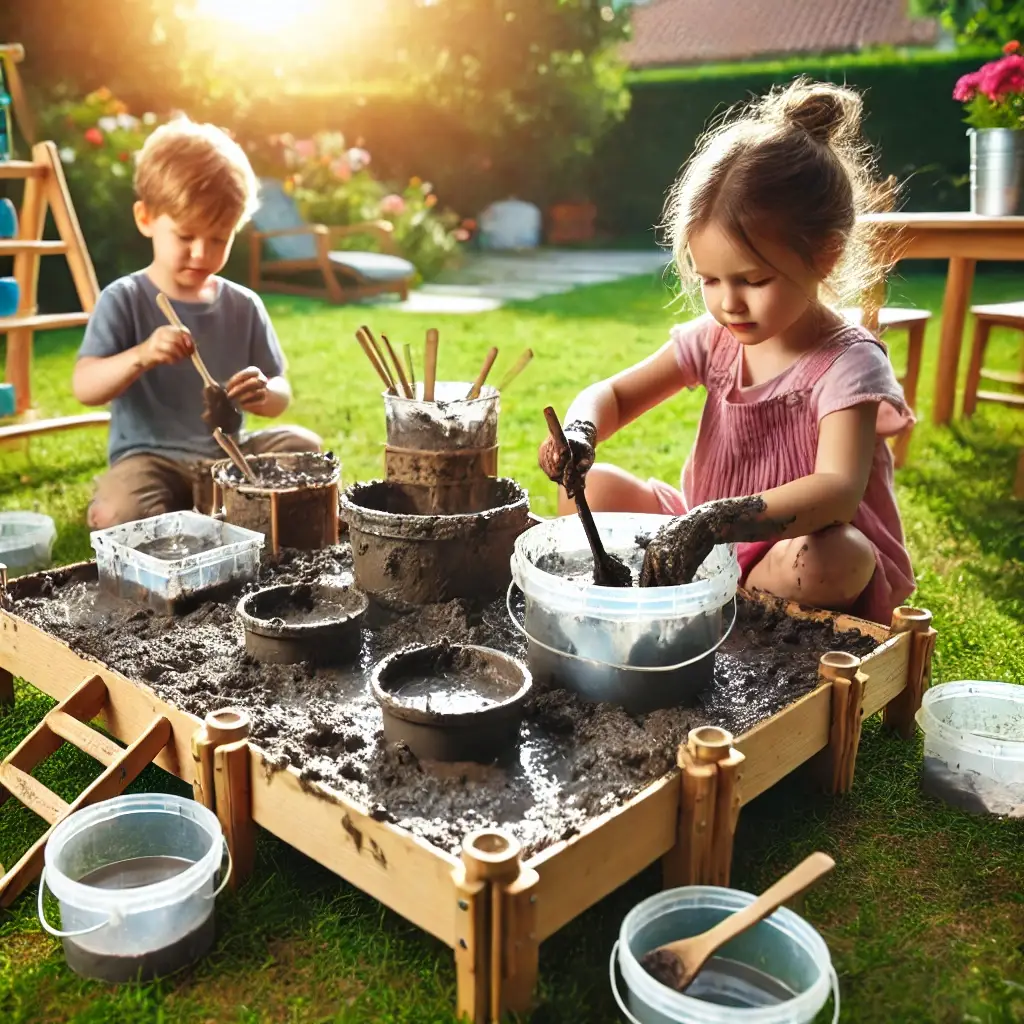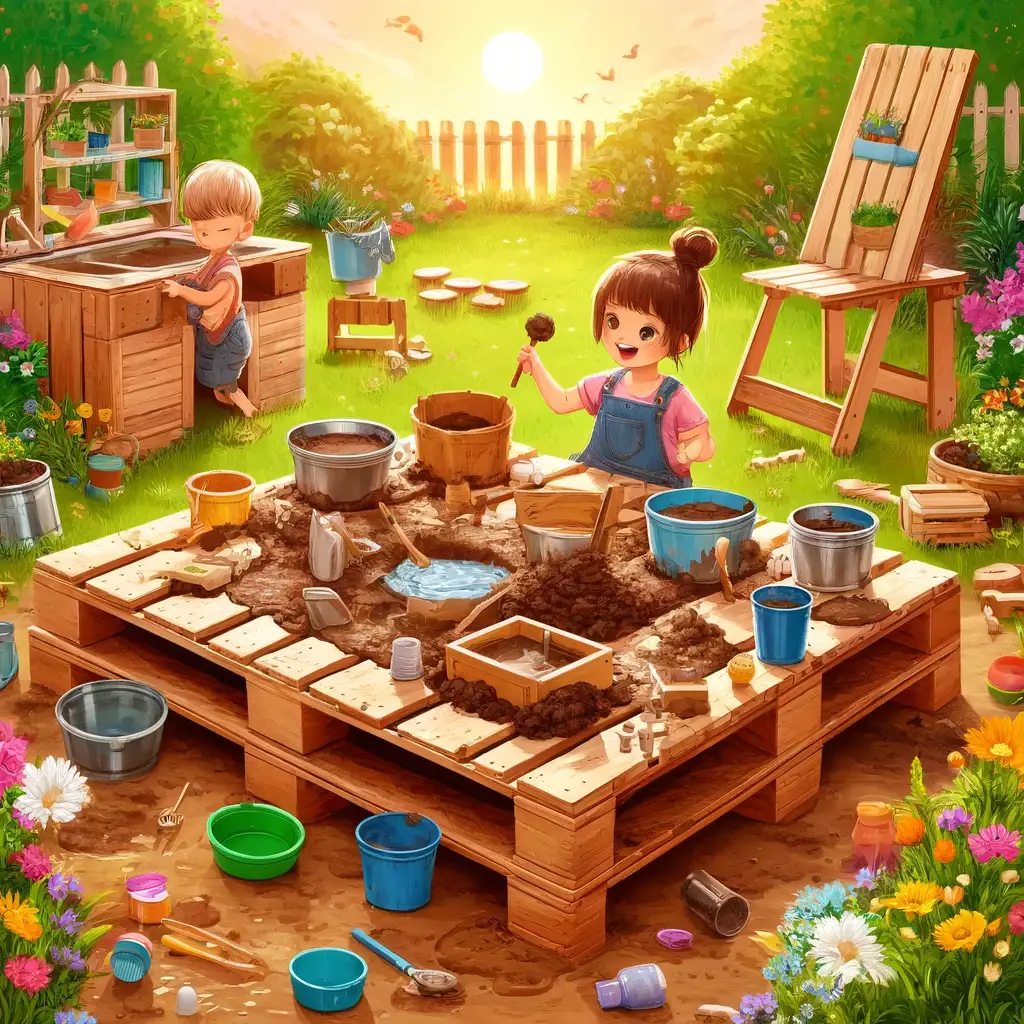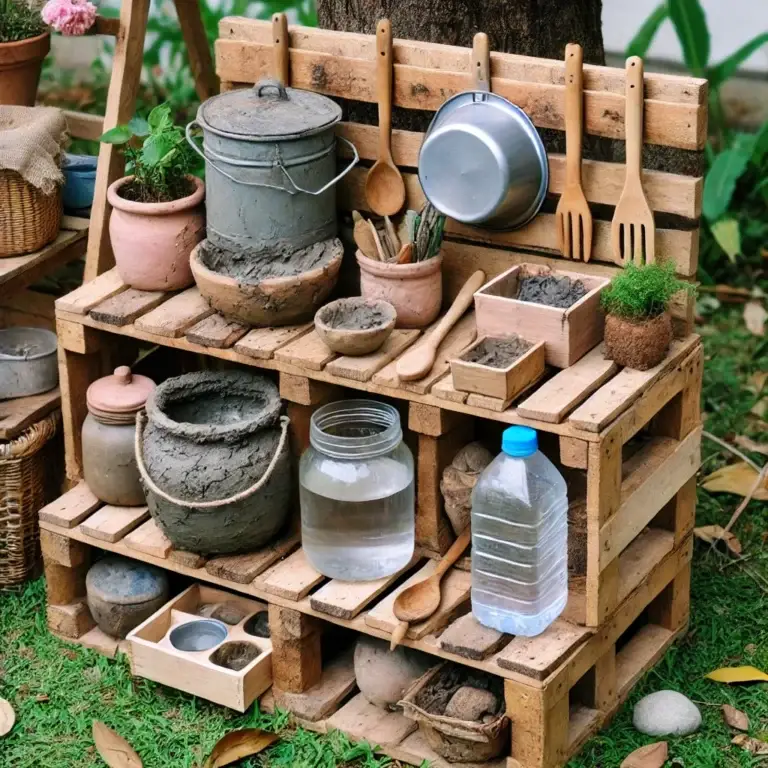Introduction.
Mud Kitchen Plans will make your child engaged, busy and help them improve their creativity and cognitive development. In case you wish to add some Mud Kitchen Plans in your backyard or garden, this blog will provide you with 10 mud kitchen plans which can be a source of fun for the kids and add creativity to the outdoor space. Such Mud Kitchen Plans do not only provide fun to the children but, also encourage children’s sensory play, imaginative roles and enriching experiences of learning.
In this comprehensive post, we will show you how to make a Mud Kitchen Plans, benefits of having one and even how you can use simple materials to create and enhance its standards. Other than the useful inspirations, these mud kitchen plans will definitely motivate beginner DIY enthusiasts to create a fun and unique play space for children in their life.
Benefits of using Mud Kitchen Plans for Children
Now let’s use the ten mud kitchen plans but before doing so let us first remember the reasons why Mud Kitchen Plans aren’t only a play area. They shape the kid in so many ways: all sorts of developmental benefits to the kids — Increased creativity and imagination through active and constructive play.
A Mud Kitchen Plans allows children to role play as a cook, a baker, a gardener, or any other profession of their liking to help them in their imaginative ability. They can make “mud pies” for their mother or invite their friends over for “stone soup” as a pretend game to further develop their imagination through make-believe play.
Encourages Sensory Play
Mixing water with soil, playing with leaves, as well as touching natural things help promote sensory development. They act on all the senses and assist the kids to have an idea of various physical properties of the shells and substances that are related to the elements.
Encourages Socialization and Communication Skills
The Mud Kitchen Plans plays another role other than the previous one and that is, they are important for social and communication development. The children have to learn to cooperate with one another, share, as well as exercise the sense of being able to take turns in imaginations. These form the basis of communication skills, basic teamwork, etc.
Foster Stem Education
From the activities conducted in the Mud Kitchen Plans, the children are able to understand some concepts of science and mathematics. They will start understanding concepts of causation, measurement, and how to apply different materials forming different shapes and textures.
Encourage Outdoor Play
Mud Kitchen Plans can be a great way to encourage children to play outside despite the technology saturation our children face today. Being outside gives children the chance to be outside and and connect with nature, get some fresh air, and do some physical activity.

Using a Mud Kitchen Plans: Basic Tools and Materials
You will require these if you wish to create your Mud Kitchen Plans DIY project. Set of mud kitchen plans below can be made from salvaged or easily available materials.
Materials:
Wooden pallets or flat pieces of wood to form the structure
Plastic buckets or containers to mix mud and water
Kitchen utensils – spoons and pans or pots
Resources such as stones, leaves, sticks and other parts of plants
Again, old kitchen devices or boxes
Nails and hooks to hold utensils
Sand to smooth out rough wood edges
Decorating paint that is harmless
Tools:
Nails and hammer
Screws and screwdriver
Tape measure
Wood cutting saw
Brushes for painting
Now, with all your materials and tools, here’s how to make your way into the 10 mud kitchen designs that you can easily do in your outdoor yard.
10 Graceful and Attractive mud kitchen plans

Plan 1: Detailed Simple Pallet Mud Kitchen Plans
This is the most straightforward and one of the most popular types of Mud Kitchen Plans. It predominantly incorporates the use of wooden pallets to form a stable structure that is utilized to hold utensils, pots and containers which are used in mud play.
How to Build:
The first stage involves the two pallets being securely placed upright, one on the back and the other on the bottom.
Coming up with a small shelf that is attached on the backward panel for putting utensils.
In the third place, mud and water containers are placed on the pallet that is located at the bottom.
Finally, a painted pallet kitchen is used since it adds one’s touch, otherwise, the barn house look is exotic.
Why I Love It:
This design, in my opinion, would be wonderful to a person who is looking to build a straightforward structure in the shortest time possible. The Mud Kitchen Plans is durable and made up of cheap materials which take nearly two hours to construct.
Construction:
Make a few large plastic containers which can be filled with dirt and water perhaps two or three such containers.
Bring in some small containers to store natural items, for example, leaves, rocks and sticks.
Make provisions for small shelves which are removable for storing utensils.
You may even add wheels for easier movement.
Why It’s Beneficial:
Because the Mud Kitchen Plans is portable it can be carried around and placed in tight outdoor areas for storage.
The Mud Kitchen Plans will fit well within your garden or natural location as stumps of trees, stones and other organic elements are utilized to create an overall natural appearance or rather make it look like an actual forest and thus helping the children to feel as if they are in the wild.
How To Construct:
Please utilize tree stumps as the stand for the kitchen.
Use flat stones or thick slabs of wood as long as possible for the top of the kitchen.
Hollow logs to store mud.
Make the place floral or surrounding with plants to help children experience the natural environment.
Why It’s Wonderful:
This kitchen is functional but offers great beauty as it is developed in such a way that will suit perfectly as a play area for children.
Design 4: The Recycled Pallet Mud Kitchen Plans This is a 100% eco-friendly mud kitchen where its components are made using recycled wooden pallets. This can be built at minimal costs and is quick in construction since it gives an organic feeling to any backyard. How To Build: Disassembled old pallets and sanded down the rough edges. Use the pallet boards for a minimalist kitchen form with a few shelves and hooks for the utensils. Mold the old metal bowl or basin to have the sink Finishing touches with paint or chalkboard labels on it and quite an engaging feature that can be enjoyed. What’s Good A recycled pallet kitchen is very ideal for those people who like up cycling products and like to have a sustainable form of there outdoor places. Plan 5: The Fancy Mud Kitchen Plans with Running Water Children love to play in more of an interactive way so incorporate a running water feature, Mud Kitchen Plans with this feature and it does truly portray a real kitchen environment. How To Make Build a simple wooden framework for your kitchen with pallets or planks.
Simply attach a garden hose to the ‘sink’ or fix a water pump that is simple to install.
Use a large container to save the water for future use.
Complete the picture by including shelves for utensils and pots.
This plan adds an extra dimension of fun and realism for a child playing with water in a Mud Kitchen Plans where they pretend to wash dishes or stir the soil for cooking in Japan.
Floor Plan 6: Corner Mud Kitchen Plans
A corner Mud Kitchen Plans is an ideal design for small spaces and can be added to your yard or garden where space is available. It can be placed anywhere in the garden and offers a usable play area.
Select a corner within the boundary of a garden then look for how much space is left.
Make a small structure with wooden planks or reuse materials, keeping more vertical storage rather than horizontal so that the floor area can be used for other things.
Make shelves and hangers to store utensils and containers.
Paint it up or perhaps you could use branches and other natural elements that would add character to it
Why This Is Fantastic:
This little corner kitchen, which does not require this kitchen to be placed in an outdoor space, is an excellent option for homes. It is compact, simple to construct, and possesses the same level of interactivity associated with bigger mud kitchens.
Plan 7: Multi Level Mud Kitchen Plans
If on the other hand your expectation is to have a more vigorous play from the children at the kitchen area then it would be best to consider using the multi level Mud Kitchen Plans. With this configuration, children would be able to play at different levels thus providing a more interesting and varied playing experience.
How to Construct
To begin with, you should construct the bottom layer of this Mud Kitchen Plans from wooden pallets or boards.
Erect a level above the children’s height where they could place their water container or mix the mud from a higher position.
For the lower floor, a good application is for the wider containers or pots.
The upper level should definitely have the steps or ramps that lead to it.
It’s Great Because:
This design allows for greater activities as children are always moving from one level to the other as they play. It also adds aesthetic value to the outdoor playing space.
Plan 8: Themed Mud Kitchen Plans – Café or Bakery
What if your mud kitchen becomes a more fun installed a fake café or a fake bakery? This theme of mud kitchen is like that one spiced up creative touch and promotes role play games!
Instructions
Make an effort to construct a very simple and rudimentary mud kitchen from pallets or wooden planks.
Add a small counter area where children can ‘sell’ their ‘creations.’
Ask them to create a board with chalkboard paint and call it a menu board.
Suggest including props like a toy cash register and other café décor to make the theme more plausible.
Why It’s Awesome
This mud kitchen is best for the child who dreams to own a café or a bakery and wish to serve people. It is also very engaging as it promotes parallel and cooperative play.

Design 9: Mud Kitchen Tree Stumps and Rocks comprising Nature Inclusive
In order to perfectly have a very organic appeal, integrate tree stumps and big boulders on your mud kitchen. It uses natural resources that are available in your backyard.
How to Build
Tree stumps should be your working units.
Big flat rocks should be used for water container surfaces and where other utensils can be placed.
Mount some plants, flowers or shrubs in the area as a complete design for your theme.
Leaves and sticks can be used as “ingredients” when engaging in the mud play.
Why It’s Awe Inspiring:
The above mud kitchen concept enables children to form relationships with nature as they play. This is because you make use of outside products hence it is not expensive.
A mobile mud kitchen means that you can move the play area around the yard or put it in the store when not in use. This makes it ideal for small families or those who wish to maintain flexibility in outdoor spaces.
How to Put Together:
Build a simple mud kitchen, using wooden planks or pallets.
Attach wheels at the base of the kitchen so that it is possible to roll the kitchen around.
Put up shelves and hooks to keep the containers and utensils and other equipment neat and organized.
Paint, labels or other little pretty things can be used to embellish the kitchen in a more personal manner.
Why You Are Going To Love It:
This is a portable mud kitchen and can be convenient for people with flexible outdoor spaces. The best way to use it and keep it indoors if the weather is bad.
How to Make Your Mud Kitchen Stand Out from the Rest
Now that you have constructed your mud kitchen, it’s time to decorate and add some special touches to it! Here are some ideas that can inspire you to make your mud kitchen plans unique: You can include a blackboard: This will help children write down their “recipes” alongside any special items, which will help them on that particular day.
Incorporate real kitchen tools: Real kitchen includes old kitchen tools such as pots pans and even utensils.
Use natural resources: Try to decorate your kitchen with flowers, leaves, and branches to enhance the natural feel.
Painting and labeling: You may use non-toxic paint to add colors to the accents or label boxes around as a part of an active learning activity.
Upkeep Preparing yourself for a prolonged period of enjoyment
To ensure that a mud kitchen is sturdy and durable, it will need a little bit of regular upkeep. You can follow these suggestions:
Wash once in a while – properly remove any old mud, leaves and other trash and debris on the surface to keep it neat and hygienic.
Apply good weatherproof sealants on the wood surfaces so that there is no standing water after rains which can do a lot of harm to the wood.
When not in use, cover utensils and containers in a shed or a storage box to avoid the chances of breakages and other types of losses.
Keep an eye on the toddlers: Younger children should always be under supervision so that they don’t use the mud kitchen in a reckless and inappropriate manner.
Frequently Asked Questions (FAQs)
Q1: What is the minimum age for children to engage in activities at the mud kitchen?
A: A child may utilize a mud kitchen at the age of 2 years and above. Little children should always be kept under surveillance wherever possible.
Q2: Are there mud kitchens available for purchase or is it necessary to build one?
A: Yes, there is a lot of ready mud kitchens available in the market. But the benefit of building one is that you can customize it to fit your space and style.
Q3: What are the dimensions for the mud kitchen I intend to make?
A: There is no standard size for the mud kitchens; they can be as big or small as you like. Some are smaller in design and can easily tuck into a corner of the garden and some are larger with multiple tiers and different features.
Q4: What do you recommend shunning when constructing a mud kitchen?
A: Harming materials of any kind or paints are not any recommended use. Use materials that are completely child-friendly and can withstand weather elements of any kind.
Conclusion
How Much to Make a DIY Outdoor Mud Kitchen. Making a doughnut kitchen outside for your kids is great because it provides fun while also teaching kids various types of activities. These 10 mud kitchen plans will definitely be ideal if you using a simple pallet design or a more complex one equipped with water getting everything together and having fun outdoors with the children.
It doesn’t require much effort and just a tool or two only that you have to be unique in your designing – just place it in the most idyllic spot in your garden and start it off. So stop waiting, get the materials and start working right now!

